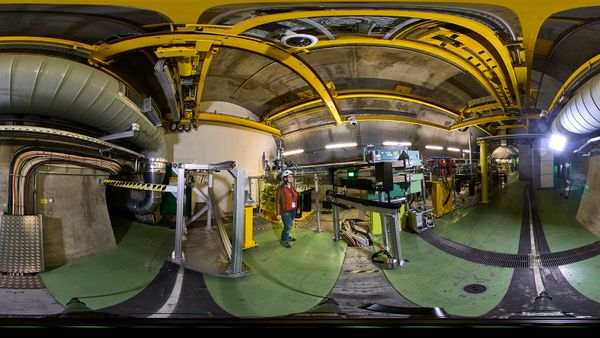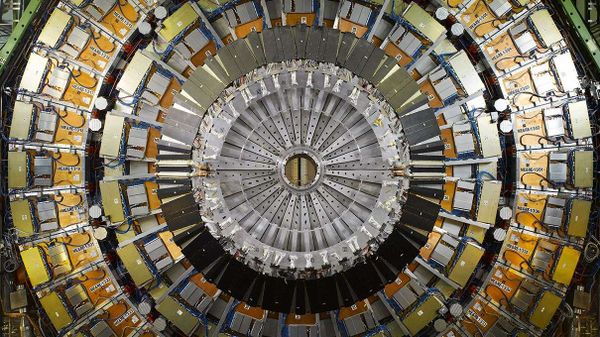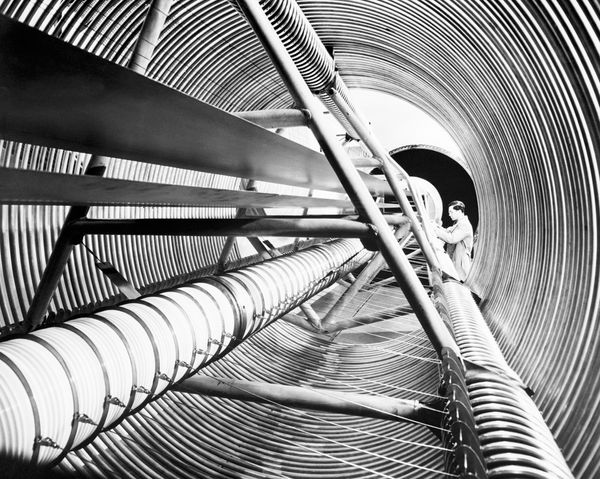
Fun fact: When physicists made the historic discovery of theHiggs bosonin 2012 using the world's most powerfulparticle accelerator, they didn'tdirectlydetect the elusive particle. Instead, they homed in on ol' Higgsy's fingerprint – a fingerprint composed of other particles. Now, physicists analyzing the oodles of data that was collected from theLarge Hadron Collider (LHC)'s first two experimental runs have foundanotherHiggs fingerprint. And it's different from the 2012 discovery but, possibly, more profound.
Before we get into particle fingerprints, let's revisit what physicists look for in the building-sized detectors located around the LHC's 17-mile (27-kilometer) ring ofsuperconductingmagnets. The LHC accelerates billions of charged particles (such as protons) to close to the speed of light and, through the use of extremely precise magnetic fields, the accelerator collides these particle beams with other particle beams being accelerated in the opposite direction. The resulting head-on particle smashup produces intense energy – the kind of energy that the universe hasn't seen since the Big Bang, some 13.8 billion years ago. These particle collisions replicate the conditions of the Big Bang, only on a infinitesimally miniaturized scale.
Advertisement
In the wake of these billions of mini big bangs, the extremely concentrated energy condenses into new particles that don't regularly exist in nature, like the Higgs boson, a particle that was theorized way back in the 1960s by Peter Higgs and François Englert.
The Higgs particle is a gauge boson, or the intermediary between the Higgs field and matter. The Higgs field is thought to be ubiquitous throughout the universe. That field gives matter its mass, and the Higgs boson was the "missing piece" of the Standard Model of particle physics, a recipe book for how all matter in the universe should work. Not surprising, then, that its discovery resulted in the 2013 Nobel Prize in Physics going to Higgs and Englert.
As we already pointed out, the LHC can't directly detect the Higgs boson. This unstable particle decays far too fast for even the most advanced detector to see. When it decays, it creates decay products – basically regular subatomic particles that don't decay as fast. It's like a firework rocket with a very short fuse; you only see the firework (Higgs boson) when it explodes (regular decay particles).
Physicists made their 2012 discovery courtesy of the CMS and ATLAS experiments at the LHC, which uncovered an "excess" of photons emerging from the noise of particle collisions. And they weren't just any photons. These photons pointed to the existence of a particle with a mass of around125 GeV(that's approximately 133 times the mass of a proton) – a theorized decay process that predicts a Higgs boson breaking down into a pair of photons. But physicists thought that the Higgs boson might have other ways to decay (called "decay channels"), and now physicists have detected the Higgs' favorite decay channel – when it turns into a bottom quark (the second heaviest of six flavors of quarks) and its antimatter sibling, an anti-bottom quark.
This is big news. The Higgs boson is theorized to decay into pairs of bottom quarks nearly 60 percent of the time. In comparison, the Higgs is predicted to decay into pairs of photons only 30 percent of the time. And did we mention that it's really hard to detect the Higgs' bottom quark decay fingerprint? So hard that it took six years to do.
"Finding just one event that looks like two bottom quarks originating from a Higgs boson is not enough," said scientist Chris Palmer, of Princeton University, in astatement。“我们需要分析数百人of thousands of events before we could illuminate this process, which is happening on top of a mountain of similar-looking background events."
Now physicists have done it, and by studying the Higgs' most favorable decay process, they can use it as a tool to investigate physics beyond the Standard Model.
Advertisement





